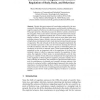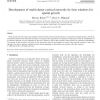23 search results - page 3 / 5 » On the non-uniform complexity of brain connectivity |
CONNECTION
2010
13 years 4 months ago
2010
Abstract. Despite the great amount of knowledge produced by the neuroscientific literature affective phenomena, current models tackling noncognitive aspects of behavior are often b...
TNN
2010
13 years 1 months ago
2010
In this paper we provide theoretical and numerical analysis of a geometric activity flow network model which is aimed at explaining mathematically the scale-free functional graph s...
IJON
2007
13 years 6 months ago
2007
Many neural networks, such as the complex cortical networks of the mammalian brain, are organized in multiple clusters, with many connections within but few links between clusters...
ISBI
2006
IEEE
14 years 1 months ago
2006
IEEE
The relationship between brain structure and complex behavior is governed by large-scale neurocognitive networks. Diffusion weighted imaging(DWI) is a noninvasive technique that c...
ISBI
2011
IEEE
12 years 10 months ago
2011
IEEE
For medical image analysis, the test statistic of the measurements is usually constructed at every voxels in space and thresholded to determine the regions of significant signals...


